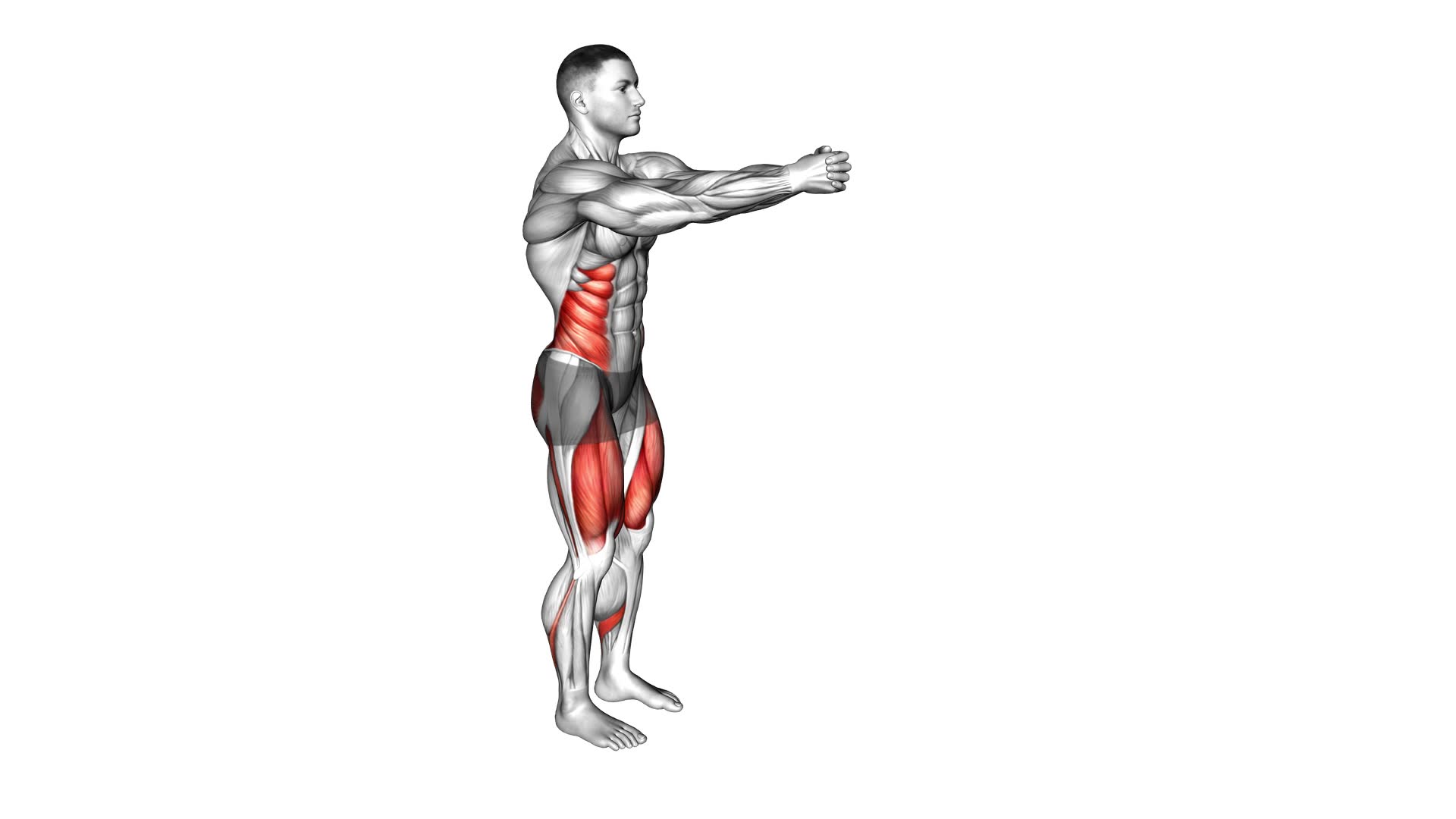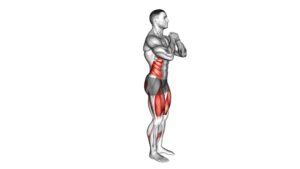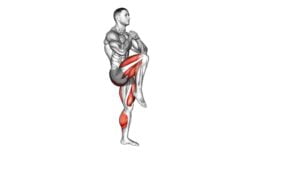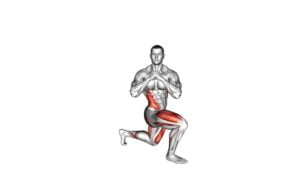Lunge Twist (male) – Video Exercise Guide & Tips

Get ready to take your workout to the next level with the Lunge Twist! This dynamic exercise targets your legs, core, and obliques for a full-body burn.
Watch This Exercise Video
In this video exercise guide, we'll show you the proper form and technique, as well as modifications for different fitness levels. Avoid common mistakes and learn valuable tips for incorporating the Lunge Twist into your workout routine.
Let's get started and achieve those fitness goals!
Key Takeaways
- The lunge twist targets the legs, core, and obliques for a full-body burn.
- Proper form and technique are important, with the twist originating from the core and being initiated by rotating the hips.
- Modifications can be made for different fitness levels, such as reducing lunge depth for beginners or adding weight for experienced individuals.
- Common mistakes to avoid include rounding the back, over-rotating, and not maintaining proper lunge form.
Benefits of the Lunge Twist
Experience the numerous benefits of the Lunge Twist as you engage your core muscles and improve your balance and flexibility.
The Lunge Twist is a dynamic exercise that combines the lunge and torso rotation movements, targeting multiple muscle groups in your body.
One of the key benefits of this exercise is improved core strength. As you perform the Lunge Twist, your core muscles are activated to stabilize your body and maintain balance throughout the movement. This helps to strengthen your abs, obliques, and lower back muscles, leading to better posture and overall stability.
Another benefit of the Lunge Twist is increased flexibility. As you lunge forward and rotate your torso, you're stretching and lengthening the muscles in your hips, thighs, and upper body. This can help to improve your range of motion and enhance your athletic performance. Additionally, the twisting motion engages your spinal muscles, promoting spinal mobility and reducing the risk of back pain and injury.
Incorporating the Lunge Twist into your workout routine can be a great way to challenge your core muscles, improve your balance, and increase your flexibility. Remember to maintain proper form and engage your core throughout the exercise for maximum benefits.
Proper Form and Technique
To perform the Lunge Twist with proper form and technique, consistently engage your core muscles throughout the exercise. This will help you maintain stability and control as you twist your torso. Here are some important points to keep in mind:
- Common misconceptions: One common misconception is that you should only twist your upper body during the exercise. However, it's important to remember that the twist should originate from your core and be initiated by rotating your hips. Another misconception is that you should rush through the exercise. Take your time and focus on maintaining proper form and control throughout each repetition.
- Variations: Once you have mastered the basic Lunge Twist, you can try different variations to challenge yourself further. One variation is to hold a dumbbell or kettlebell in your hands to add resistance. Another variation is to perform the exercise on an unstable surface, such as a Bosu ball, to engage your core muscles even more.
- Progressions: As you become more comfortable with the Lunge Twist, you can progress by increasing the weight or resistance, increasing the number of repetitions, or incorporating it into a circuit workout for a greater challenge.
By following these guidelines, you can ensure that you're performing the Lunge Twist with proper form and technique, maximizing its benefits and minimizing the risk of injury.
Now, let's move on to the next section where we'll discuss modifications for different fitness levels.
Modifications for Different Fitness Levels
For each fitness level, there are specific modifications that can be made to the Lunge Twist exercise. If you're a beginner, there are scaling options available to help you ease into this exercise. One modification you can try is to reduce the depth of your lunge. Instead of stepping forward into a deep lunge, you can take smaller steps and limit the range of motion. This will allow you to focus on maintaining proper form and stability. Additionally, you can start by performing the exercise without weights or with lighter weights to reduce the intensity.
On the other hand, if you're an experienced individual looking for a challenge, there are advanced variations of the Lunge Twist that you can try. One option is to add weight to the exercise by using dumbbells or a weighted vest. This will increase the resistance and make the exercise more challenging for your muscles. Another variation is to perform the exercise on an unstable surface, such as a balance board or a BOSU ball. This will engage your core muscles even more as you work to maintain your balance.
Common Mistakes to Avoid
Avoid these common mistakes when performing the Lunge Twist exercise. Proper form is crucial to maximize the effectiveness of this exercise and prevent injuries. Here are some common mistakes to watch out for:
- Rounding your back: Keep your back straight throughout the movement. Avoid rounding or hunching your back as it can strain your spine.
- Over-rotating: While twisting, it's important to maintain control and not over-rotate. Over-rotating can lead to strain on your spine and cause discomfort.
- Neglecting proper lunge form: Remember to maintain proper lunge form throughout the exercise. Keep your front knee aligned with your ankle and ensure your back knee is hovering just above the ground. This will help engage your leg muscles effectively.
By avoiding these common mistakes and focusing on proper form, you can maximize the benefits of the Lunge Twist exercise. Engaging your core, legs, and oblique muscles, this exercise can help improve stability, enhance balance, and strengthen your lower body.
Remember to start with light weights and gradually increase the intensity as you become more comfortable with the exercise. As always, consult with a fitness professional before starting any new exercise routine.
Tips for Incorporating the Lunge Twist Into Your Workout Routine
To incorporate the Lunge Twist into your workout routine, focus on maintaining proper form and engaging your core and leg muscles. This exercise is a great way to strengthen your lower body and improve your balance and stability. Here are some tips to help you incorporate the Lunge Twist effectively:
- Start with proper form: Begin by standing with your feet hip-width apart and your hands clasped in front of your chest. Take a step forward with your right foot and lower your body into a lunge position, keeping your right knee directly above your ankle. Keep your back straight and your core engaged.
- Engage your core and leg muscles: As you lunge forward, twist your torso to the right, bringing your left elbow towards your right knee. This will engage your core muscles and increase the intensity of the exercise. Make sure to keep your hips facing forward and your back straight throughout the movement.
- Try different variations: Once you have mastered the basic Lunge Twist, you can add variations to challenge yourself even more. You can try holding a dumbbell or kettlebell in front of your chest to increase resistance, or perform the exercise on an unstable surface like a Bosu ball to engage your stabilizer muscles.
- Use lunge twist equipment: While the Lunge Twist can be performed with just your bodyweight, incorporating equipment like resistance bands or medicine balls can add variety and intensity to your workout. These tools can provide added resistance and help you target specific muscle groups.
Incorporating the Lunge Twist into your workout routine can add variety and challenge to your lower body training. By focusing on proper form and engaging your core and leg muscles, you can maximize the benefits of this exercise and achieve your fitness goals.
Frequently Asked Questions
Is the Lunge Twist Exercise Suitable for Beginners?
The lunge twist exercise can be suitable for beginners with some modifications. It's important to start with a basic lunge position and gradually add the twisting motion.
This exercise helps to improve balance, strengthen the core, and target the hip and thigh muscles. By engaging multiple muscle groups, it can also enhance overall stability and coordination.
Remember to listen to your body and start with lighter weights or no weights at all when starting out.
Can the Lunge Twist Exercise Help Improve Posture?
Incorporating the lunge twist exercise into your workout routine can have numerous benefits, including improving your posture.
To perform this exercise properly for optimal results, start by standing with your feet hip-width apart and lunge forward with one leg while keeping your back straight.
Then, twist your torso towards the side of your front leg. This movement engages your core, strengthens your lower body, and helps align your spine, leading to improved posture.
How Many Calories Can Be Burned by Performing the Lunge Twist Exercise?
Incorporating the lunge twist exercise into your fitness routine offers numerous benefits. Not only does it help improve your posture, but it also aids in burning calories.
To maximize calorie burn, it's crucial to perform the lunge twist exercise correctly. Engage your core, keep your back straight, and twist your torso as you lunge forward.
Are There Any Variations of the Lunge Twist Exercise That Target Specific Muscle Groups?
There are indeed variations of the lunge twist exercise that target specific muscle groups.
By adding weights to the lunge twist, you can increase the resistance and work your muscles even harder.
Some variations include the dumbbell lunge twist, which targets the shoulders and arms, and the medicine ball lunge twist, which engages the core and upper body.
These variations offer a range of benefits and help you achieve a more comprehensive workout.
Can the Lunge Twist Exercise Be Done Without Weights or Equipment?
You can definitely do the lunge twist exercise without weights or equipment. This exercise targets your core muscles, especially the obliques, and helps improve stability and balance.
To do it without weights, simply perform a lunge by stepping forward with one foot and bending both knees. Then, twist your torso towards the front leg while keeping your back straight.
This exercise is a great alternative to strengthen your core and add variety to your workout routine.
Conclusion
Incorporating the lunge twist into your workout routine can provide numerous benefits, including improved core strength, balance, and flexibility. By following proper form and technique, and making modifications for different fitness levels, you can maximize the effectiveness of this exercise.
It's important to avoid common mistakes, such as twisting too far or not engaging the core muscles properly. With these tips in mind, you can confidently add the lunge twist to your fitness routine for optimal results.

Author
Years ago, the spark of my life’s passion ignited in my mind the moment I stepped into the local gym for the first time. The inaugural bead of perspiration, the initial endeavor, the very first surge of endorphins, and a sense of pride that washed over me post-workout marked the beginning of my deep-seated interest in strength sports, fitness, and sports nutrition. This very curiosity blossomed rapidly into a profound fascination, propelling me to earn a Master’s degree in Physical Education from the Academy of Physical Education in Krakow, followed by a Sports Manager diploma from the Jagiellonian University. My journey of growth led me to gain more specialized qualifications, such as being a certified personal trainer with a focus on sports dietetics, a lifeguard, and an instructor for wellness and corrective gymnastics. Theoretical knowledge paired seamlessly with practical experience, reinforcing my belief that the transformation of individuals under my guidance was also a reflection of my personal growth. This belief holds true even today. Each day, I strive to push the boundaries and explore new realms. These realms gently elevate me to greater heights. The unique combination of passion for my field and the continuous quest for growth fuels my drive to break new ground.







